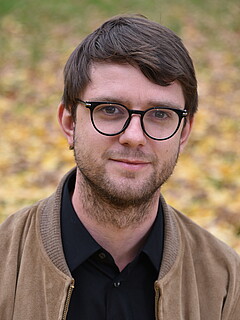PhD students 2nd cohort

Dr. Martin Ehrler
Curriculum Vitae
Martin Ehrler (born 1989) studied at the University of Greifswald from 2008 to 2012 attaining his Bachelor’s degree with a major in Scandinavian philology. From 2012 to 2015 he completed his Master‘s in General and Comparative Literature at the University of Leipzig. From 2015 to 2018 he worked as a research fellow at the Martin-Luther-Universität Halle Wittenberg on the project “Experimentierfeld Dorf”, which the Volkswagen Foundation funded. He has been a PhD student at the ‘Romanticism as a Model’ research training group since October 2018.
PhD project
Non-landscapes. Beginning and end of an aesthetic model
Landscapes have since their considerable enhancement in aesthetic and philosophical endeavours of the 1800s accounted for relevant and accessible components of art production and reception. The iconic reservoir and interpretive patterns of Romanticism continue to influence the images and imaginations of landscape. However, there is a growing rift between these transmitted ideas and their expressions of landscape and the increasingly varying forms of landscape which are often described as hybrid, provisional or post-modern.
Visual and pictorial traditions have experienced minimal changes in the last two centuries and yet continue to influence judgments of landscape and their imaginations. Because of this ideal image of landscape and its culture-historical continuity, there is an emerging awareness in dealing with anthropogenic landscapes, which the traditional models and its formal categories cannot adequately express.
Around 1800, the perceivable disruption of the relationship between human beings and the natural environment established aestheticised landscapes as centrepieces of pictorial, literary and musical compositions. The subversive potential of the genre, which was somewhat marginal in the traditional genre hierarchy revealed an ideal place for the negotiation of romantic distinctions in the fields of theory and practice.
Does the concept of a landscape that is heavily influenced by Romantic ideas have a place in current discourse? This has been and is still the subject of considerable debate. Especially regarding profoundly transformed anthropogenic land, the question should be if these landscapes – in an aesthetic sense – are still part of the same object range. The research, therefore, has its starting point in analysing the classical aesthetic understanding of landscape and its discourse in German romanticism and on these (still valid) interpretive patterns. The aestheticizations of postmodern landscapes – that is one assumption of the thesis – use these romantic ideas from philosophy and art, and with the focus on them, they reveal the underlying problem of designed landscapes.
The methods of the aestheticisation of modern media bring to the fore the debates of the romantic period about the portrayability and artistic merit of landscapes and their orientation to heavily moulded anthropogenic landscapes.
Publications
Edited volumes
- Hg. mit Marc Weiland: Topografische Leerstellen. Ästhetisierungen verschwindender und verschwundener Dörfer und Landschaften, Bielefeld 2018.
Articles
- Der Dichter erscheint im Anthropozän. Friedrich von Hardenberg und Wolfgang Hilbig, in: Norman Kasper/Gert Theile (Hg.): Asozialität und Aura. Wolfgang Hilbig und die Romantik, Paderborn 2017, S. 145-168.
- Leere Landschaften. Grenzfälle kultureller Deutungen von Landschaften in Literatur und Kunst, in: Martin Ehrler/Marc Weiland (Hg.): Topografische Leerstellen. Ästhetisierungen verschwindender und verschwundener Dörfer und Landschaften, Bielefeld 2018, S. 119-142.
- „Die Pyramide Jahr zu Jahr größer, wehe der Schotter rutscht“. Einar Schleefs Sangerhausen, in: Nell, Werner/Weiland, Marc (Hg.): Kleinstadtliteratur. Erkundungen eines Imaginationsraums ungleichzeitiger Moderne, Bielefeld 2020, S. 423-438.